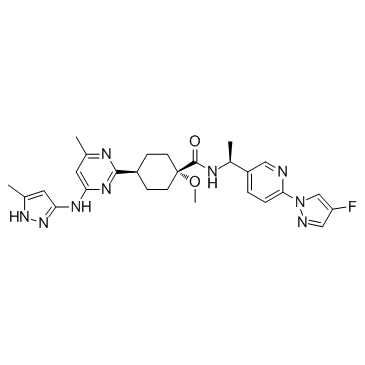Pralsetinib (BLU-667)
Modify Date: 2024-01-14 16:46:53

Pralsetinib (BLU-667) structure
|
Common Name | Pralsetinib (BLU-667) | ||
|---|---|---|---|---|
| CAS Number | 2097132-94-8 | Molecular Weight | 533.6 | |
| Density | N/A | Boiling Point | N/A | |
| Molecular Formula | C27H32FN9O2 | Melting Point | N/A | |
| MSDS | N/A | Flash Point | N/A | |
Use of Pralsetinib (BLU-667)Blu667 is a highly potent and selective RET inhibitor with an IC50 of 0.4 nM for wild type RET kinase. |
| Name | Blu667 |
|---|
| Description | Blu667 is a highly potent and selective RET inhibitor with an IC50 of 0.4 nM for wild type RET kinase. |
|---|---|
| Related Catalog | |
| Target |
IC50: 0.12 nM (Wild type RET)[2] |
| In Vitro | Blu667 is a RET inhibitor extracted from patent US20170121312A1, compound example 129[1]. BLU-667 demonstrates more than 10-fold increased potency over approved MKIs against oncogenic RET variants and resistance mutants. BLU-667 demonstrates potent activity (IC50=0.4 nM) against common oncogenic RET alterations, including RET M918T, an activating mutation found in MTC, as well as the CCDC6-RET fusion observed in PTC and NSCLC. BLU-667 suppresses RET pathway signaling in a panel of RET-driven cell lines: LC2/ad (CCDC6-RET, NSCLC), MZ-CRC-1 (RET M918T, MTC), and TT (RET C634W, MTC)[2]. |
| In Vivo | BLU-667 potently inhibits growth of NSCLC and thyroid cancer xenografts driven by various RET mutations and fusions without inhibiting vascular endothelial growth factor receptor 2 (VEGFR-2). BLU667 showed potent dose dependent activity against both KIF5B-RET Ba/F3 and KIF5B-RET V804L Ba/F3 allograft tumors with doses as low as 10 mg/kg twice-daily[2]. |
| Cell Assay | KIF5B-RET Ba/F3 cells are exposed to compound concentrations ranging from 25 µM to 95.4 pM for 48 hours, and proliferation is assessed with Cell Titer Glo. TT, MZ-CRC-1, TPC-1 or LC2/ad cells are exposed to compound for 4 days and proliferation is measured by BrdU incorporation[2]. |
| Animal Admin | Mice[2] BALB/c nude mice are inoculated subcutaneously into the right flank with KIF5B-RET Ba/F3 cells, KIF5B-RET V804L Ba/F3 cells, or TT cells. For all experiments, mice are dosed twice-daily with vehicle, 3 mg/kg, 10 mg/kg, or 30 mg/kg BLU-667 or once-daily with 60 mg/kg BLU-667 or 60 mg/kg cabozantinib[2]. |
| References |
| Molecular Formula | C27H32FN9O2 |
|---|---|
| Molecular Weight | 533.6 |